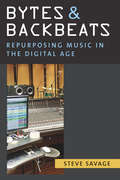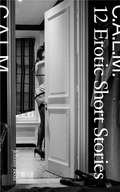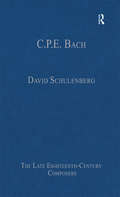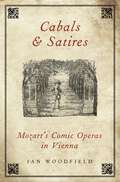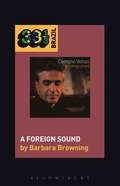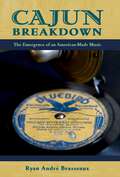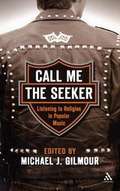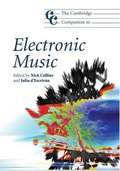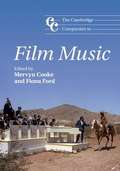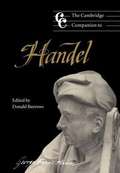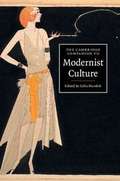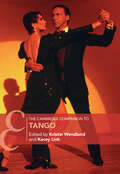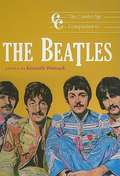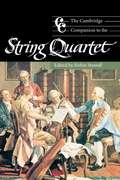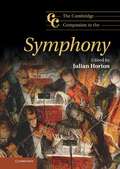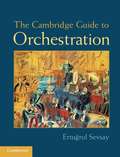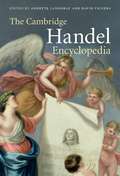- Table View
- List View
Bytes and Backbeats: Repurposing Music in the Digital Age (Tracking Pop)
by Steve SavageFrom Attali's "cold social silence" to Baudrillard's hallucinatory reality, reproduced music has long been the target of critical attack. In Bytes and Backbeats, however, Steve Savage deploys an innovative combination of designed recording projects, ethnographic studies of contemporary music practice, and critical analysis to challenge many of these traditional attitudes about the creation and reception of music. Savage adopts the notion of "repurposing" as central to understanding how every aspect of musical activity, from creation to reception, has been transformed, arguing that the tension within production between a naturalizing "art" and a self-conscious "artifice" reflects and feeds into our evolving notions of creativity, authenticity, and community. At the core of the book are three original audio projects, drawing from rock & roll, jazz, and traditional African music, through which Savage is able to target areas of contemporary practice that are particularly significant in the cultural evolution of the musical experience. Each audio project includes a studio study providing context for the social and cultural analysis that follows. This work stems from Savage's experience as a professional recording engineer and record producer.
C.A.L.M.: Crimes Against Love Memories
by Jehnny Beth Johnny Hostile'Because a life lived in fear is equal to no life at all'This is the uncompromising vision of Jehnny Beth and Johnny Hostile. Fearless and highly erotic, these stories delight in ideas of sexual transgression and liberation, offering a window onto a world where anything is permitted, and everything is safe. As each of Jehnny Beth and Johnny Hostile's characters break from the bonds of acceptability and enter a darkness of desire, submission and sex, they discover their own humanity, a place where they can truly be free. A manifesto in the form of erotic photography, monologues and dialogues, Johnny Hostile's stimulating photography punctuates Jehnny Beth's seductive prose. Collapsing the barriers between sex an art while examining the universal values of human existence and consciousness through uninhibited desire, C.A.L.M. established Jehnny Beth and Johnny Hostile as two of the bravest and most provocative voices in fiction and erotic art today. The full collection of Johnny Hostile's photography is featured in a limited-edition hard cover art book of C.A.L.M.
C.P.E. Bach
by David SchulenbergThe second son of Johann Sebastian Bach, C.P.E. Bach was an important composer in his own right, as well as a writer and performer on keyboard instruments. He composed roughly a thousand works in all the leading genres of the period, with the exception of opera, and Haydn, Mozart and Beethoven all acknowledged his influence. He was also the author of a two-volume encyclopedic book about performance on keyboard instrument. C.P.E. Bach and his music have always been the subject of significant scholarship and publication but interest has sharply increased over the past two or three decades from performers as well as music historians. This volume incorporates important writings not only on the composer and his chief works but also on theoretical issues and performance questions. The focus throughout is on relatively recent scholarship otherwise available only in hard-to-access sources.
C.P.E. Bach (The\late Eighteenth-century Composers Ser.)
by David SchulenbergThe second son of Johann Sebastian Bach, C.P.E. Bach was an important composer in his own right, as well as a writer and performer on keyboard instruments. He composed roughly a thousand works in all the leading genres of the period, with the exception of opera, and Haydn, Mozart and Beethoven all acknowledged his influence. He was also the author of a two-volume encyclopedic book about performance on keyboard instrument. C.P.E. Bach and his music have always been the subject of significant scholarship and publication but interest has sharply increased over the past two or three decades from performers as well as music historians. This volume incorporates important writings not only on the composer and his chief works but also on theoretical issues and performance questions. The focus throughout is on relatively recent scholarship otherwise available only in hard-to-access sources.
Cabals and Satires: Mozart's Comic Operas in Vienna
by Dr. Ian WoodfieldWhen Joseph II placed his opera buffa troupe in competition with the re-formed Singspiel, he provoked an intense struggle between supporters of the rival national genres, who organized claques to cheer or hiss at performances, and encouraged press correspondents to write slanted notices. It was in this fraught atmosphere that Mozart collaborated with librettist Lorenzo da Ponte on his three mature Italian comedies--Figaro, Don Giovanni, and Così fan tutte. In Cabals and Satires: Mozart's Comic Operas in Vienna, Ian Woodfield brings the fascinating dynamics of this inter-troupe contest into focus. He reveals how Mozart, while not immune from the infighting, was able to weather satirical attacks, successfully negotiate the unpredictable twists and turns of theatre politics during the lean years of the Austro-Turkish War, and seal his reputation with a revival of Figaro in 1789 as a Habsburg festive work. Mozart's deft navigation of the turbulent political waters of this period left him well placed to benefit from the revival of the commercial stage in Vienna--the most enduring musical consequence of the war years.
Cabals and Satires: Mozart's Comic Operas in Vienna
by Dr. Ian WoodfieldWhen Joseph II placed his opera buffa troupe in competition with the re-formed Singspiel, he provoked an intense struggle between supporters of the rival national genres, who organized claques to cheer or hiss at performances, and encouraged press correspondents to write slanted notices. It was in this fraught atmosphere that Mozart collaborated with librettist Lorenzo da Ponte on his three mature Italian comedies--Figaro, Don Giovanni, and Così fan tutte. In Cabals and Satires: Mozart's Comic Operas in Vienna, Ian Woodfield brings the fascinating dynamics of this inter-troupe contest into focus. He reveals how Mozart, while not immune from the infighting, was able to weather satirical attacks, successfully negotiate the unpredictable twists and turns of theatre politics during the lean years of the Austro-Turkish War, and seal his reputation with a revival of Figaro in 1789 as a Habsburg festive work. Mozart's deft navigation of the turbulent political waters of this period left him well placed to benefit from the revival of the commercial stage in Vienna--the most enduring musical consequence of the war years.
Caetano Veloso’s A Foreign Sound (33 1/3 Brazil)
by Barbara BrowningWhat makes a song sound foreign? What makes it sound "American,†? or Brazilian? Caetano Veloso's 2004 American songbook album, A Foreign Sound, is a meditation on these questions-but in truth, they were questions he'd been asking throughout his career. Properly heard, the album throws a wrench into received ideas regarding the global hegemony of US popular music, and also what constitutes the Brazilian sound. This book takes listeners back through some of Veloso's earlier considerations of American popular music, and forward to his more recent experiments, in order to explore his take on the relationship between US and Brazilian musical idioms.33 1/3 Global, a series related to but independent from 33 1/3, takes the format of the original series of short, music-basedbooks and brings the focus to music throughout the world. With initial volumes focusing on Japanese and Brazilian music, the series will also include volumes on the popular music of Australia/Oceania, Europe, Africa, the Middle East, and more.
Caetano Veloso’s A Foreign Sound (33 1/3 Brazil)
by Barbara BrowningWhat makes a song sound foreign? What makes it sound “American,” or Brazilian? Caetano Veloso's 2004 American songbook album, A Foreign Sound, is a meditation on these questions-but in truth, they were questions he'd been asking throughout his career. Properly heard, the album throws a wrench into received ideas regarding the global hegemony of US popular music, and also what constitutes the Brazilian sound. This book takes listeners back through some of Veloso's earlier considerations of American popular music, and forward to his more recent experiments, in order to explore his take on the relationship between US and Brazilian musical idioms.33 1/3 Global, a series related to but independent from 33 1/3, takes the format of the original series of short, music-basedbooks and brings the focus to music throughout the world. With initial volumes focusing on Japanese and Brazilian music, the series will also include volumes on the popular music of Australia/Oceania, Europe, Africa, the Middle East, and more.
Cajun Breakdown: The Emergence of an American-Made Music (American Musicspheres)
by Ryan Andre BrasseauxIn 1946, Harry Choates, a Cajun fiddle virtuoso, changed the course of American musical history when his recording of the so-called Cajun national anthem "Jole Blon" reached number four on the national Billboard charts. Cajun music became part of the American consciousness for the first time thanks to the unprecedented success of this issue, as the French tune crossed cultural, ethnic, racial, and socio-economic boundaries. Country music stars Moon Mullican, Roy Acuff, Bob Wills, and Hank Snow rushed into the studio to record their own interpretations of the waltz-followed years later by Waylon Jennings and Bruce Springsteen. The cross-cultural musical legacy of this plaintive waltz also paved the way for Hank Williams Sr.'s Cajun-influenced hit "Jamabalaya." Choates' "Jole Blon" represents the culmination of a centuries-old dialogue between the Cajun community and the rest of America. Joining into this dialogue is the most thoroughly researched and broadly conceived history of Cajun music yet published, Cajun Breakdown. Furthermore, the book examines the social and cultural roots of Cajun music's development through 1950 by raising broad questions about the ethnic experience in America and nature of indigenous American music. Since its inception, the Cajun community constantly refashioned influences from the American musical landscape despite the pressures of marginalization, denigration, and poverty. European and North American French songs, minstrel tunes, blues, jazz, hillbilly, Tin Pan Alley melodies, and western swing all became part of the Cajun musical equation. The idiom's synthetic nature suggests an extensive and intensive dialogue with popular culture, extinguishing the myth that Cajuns were an isolated folk group astray in the American South. Ryan André Brasseaux's work constitutes a bold and innovative exploration of a forgotten chapter in America's musical odyssey.
Call Me the Seeker: Listening to Religion in Popular Music (PDF)
by Michael GilmourExploring the significance of religion to popular music, the essays in this book argue that popular songs draw from and interpret themes found in the conceptual and linguistic world of the major religions and reveal underlying attitudes in those who compose and consume them.
The Cambridge Companion To Electronic Music (Cambridge Companions To Music Ser.)
by Nick Collins Julio D'EscrivanMusicians are always quick to adopt and explore new technologies. The fast-paced changes wrought by electrification, from the microphone via the analogue synthesiser to the laptop computer, have led to a wide range of new musical styles and techniques. Electronic music has grown to a broad field of investigation, taking in historical movements such as musique concrète and elektronische Musik, and contemporary trends such as electronic dance music and electronica. The first edition of this book won the 2009 Nicolas Bessaraboff Prize as it brought together researchers at the forefront of the sonic explorations empowered by electronic technology to provide accessible and insightful overviews of core topics and uncover some hitherto less publicised corners of worldwide movements. This updated and expanded second edition includes four entirely new chapters, as well as new original statements from globally renowned artists of the electronic music scene, and celebrates a diverse array of technologies, practices and music.
The Cambridge Companion To Electronic Music (Cambridge Companions To Music Ser.)
by Nick Collins Julio D'EscrivanMusicians are always quick to adopt and explore new technologies. The fast-paced changes wrought by electrification, from the microphone via the analogue synthesiser to the laptop computer, have led to a wide diversity of new musical styles and techniques. Electronic music has grown to a broad field of investigation, taking in historical movements such as musique concrète and elektronische musik, and contemporary trends such as electronic dance music and electronica. A fascinating array of composers and inventors have contributed to a diverse set of technologies, practices and music. This book brings together some novel threads through this scene, from the viewpoint of researchers at the forefront of the sonic explorations empowered by electronic technology. The chapters provide accessible and insightful overviews of core topic areas and uncover some hitherto less publicised corners of worldwide movements. Recent areas of intense activity such as audiovisuals, live electronic music, interactivity and network music are actively promoted.
The Cambridge Companion To Film Music (Cambridge Companions To Music Ser. (PDF))
by Mervyn Cooke Fiona FordThis wide-ranging and thought-provoking collection of specially-commissioned essays provides a uniquely comprehensive overview of the many and various ways in which music functions in film soundtracks. Citing examples from a variety of historical periods, genres and film industries - including those of the USA, UK, France, Italy, India and Japan - the book's contributors are all leading scholars and practitioners in the field. They engage, sometimes provocatively, with numerous stimulating aspects of the history, theory and practice of film music in a series of lively discussions which will appeal as much to newcomers to this fascinating subject as to seasoned film music aficionados. Innovative research and fresh interpretative perspectives are offered alongside practice-based accounts of the film composer's distinctive art, with examples cited from genres as contrasting as animation, the screen musical, film noir, Hollywood melodrama, the pop music and jazz film, documentary, period drama, horror, science fiction and the Western.
The Cambridge Companion To Handel (PDF)
by Donald Burrows Jonathan CrossHandel is recognised as one of the principal creative figures in Baroque music. In this Companion acknowledged experts on Handel make their expertise accessible to the interested general reader and music lover. All the genres in which Handel composed are considered including oratorio, chamber cantata, opera, and church music, as well as works for the keyboard and orchestra. The wide-ranging, specially-commissioned essays cover topics from Handel's composing methods to his treatment of the Italian language and matters of performance practice. The background to Handel's musical career is a major theme of the volume. The opening chapters deal with his musical education in Germany and the circumstances in Italy during his time there. Most of Handel's career was based in London and important topics here include contemporary concert life and theatre management, the British and Italian musicians among whom he worked, and the librettists for the English oratorios.
The Cambridge Companion To Modernist Culture (Cambridge Companions To Culture Ser.)
by Celia MarshikModernism emerged alongside radical challenges to traditional belief systems, the reorganization of public and private spheres, new modes of visual display, and innovations in recreation and entertainment. This interdisciplinary collection focuses on the diverse inventions, products, pastimes, and creative forms that responded to and inspired American and European literature. This volume explores such wide-ranging subjects as religion, dance, and publishing, thus introducing readers to the diversity of modernist culture. The Companion serves as a valuable resource for both those undertaking the study of modernism for the first time and those seeking to expand their knowledge of modernism's cultural moment.
The Cambridge Companion To Opera Studies (Cambridge Companions To Music Ser.)
by Nicholas TillWith its powerful combination of music and theatre, opera is one of the most complex and yet immediate of all art forms. Once opera was studied only as 'a stepchild of musicology', but in the past two decades opera studies have experienced an explosion of energy with the introduction of new approaches drawn from disciplines such as social anthropology and performance studies to media theory, genre theory, gender studies and reception history. Written by leading scholars in opera studies today, this Companion offers a wide-ranging guide to a rapidly expanding field of study and new ways of thinking about a rich and intriguing art form, placing opera back at the centre of our understanding of Western culture over the past 400 years. This book gives lovers of opera as well as those studying the subject a comprehensive approach to the many facets of opera in the past and today.
The Cambridge Companion To Pop And Rock (Cambridge Companions To Music Ser.)
by Simon Frith Will Straw John Street Jonathan CrossThis Companion maps the world of pop and rock, pinpointing the most significant moments in its history and presenting the key issues involved in understanding popular culture's most vital art form. Expert writers chart the changing patterns in the production and consumption of popular music, the emergence of a vast industry with a turnover of billions and the rise of global stars from Elvis to Public Enemy, Nirvana to the Spice Girls. They trace the way new technologies - from the amplifier to the internet - have changed the sounds and practices of pop and they analyse the way maverick entrepreneurs have given way to multimedia corporations. In particular they focus on the controversial issues concerning race and ethnicity, politics, gender and globalisation. Contains full profiles of a selection of figures from the pop and rock world.
The Cambridge Companion to Tango (Cambridge Companions to Music)
by Kristin Wendland Kacey LinkTango music rapidly became a global phenomenon as early as the beginning of the twentieth century, with about 30% of gramophone records made between 1903 and 1910 devoted to it. Its popularity declined between the 1950s and the 1980s but has since risen to new heights. This Companion offers twenty chapters from varying perspectives around music, dance, poetry, and interdisciplinary studies, including numerous visual and audio illustrations in print and on the accompanying webpages. Its multidisciplinary approach demonstrates how different disciplines intersect through performative, historical, ethnographic, sociological, political, and anthropological perspectives. These thematic continuities illuminate diverse international perspectives and highlight how the art form flourished in Argentina, Uruguay and abroad, while tracing its international and cultural impact over the last century. This book is an innovative resource for scholars and students of tango music, particularly those seeking a diverse international perspective on the subject.
The Cambridge Companion To The Beatles (PDF)
by Kenneth WomackFrom Please Please Me to Abbey Road, this collection of essays tells the fascinating story of the Beatles - the creation of the band, their musical influences, and their cultural significance, with emphasis on their genesis and practices as musicians, songwriters, and recording artists. Through detailed biographical and album analyses, the book uncovers the background of each band member and provides expansive readings of the band's music. * Traces the group's creative output from their earliest recordings through their career * Pays particular attention to the social and historical factors which contributed to the creation of the band * Investigates the Beatles' unique enduring musical legacy and cultural power * Clearly organized into three sections, covering Background, Works, and History and Influence, the Companion is ideal for course usage, and is also a must-read for all Beatles fans
The Cambridge Companion to the Musical (PDF)
by Paul R Laird William A EverettContaining five completely new chapters on topics including the European musical and the creation of the show Wicked, this updated Companion continues to provide a thorough and accessible overview of one of the liveliest and most popular forms of musical performance.
The Cambridge Companion to the String Quartet (Cambridge Companions to Music) (PDF)
by Robin StowellThe Cambridge Companion to the String Quartet (Cambridge Companions to Music)
The Cambridge Companion To The Symphony (Cambridge Companions To Music Ser. (PDF))
by Julian HortonFew genres of the last 250 years have proved so crucial to the course of music history, or so vital to public musical experience, as the symphony. This Companion offers an accessible guide to the historical, analytical and interpretative issues surrounding this major genre of Western music, discussing an extensive variety of works from the eighteenth century to the present day. The book complements a detailed review of the symphony's history with focused analytical essays from leading scholars on the symphonic music of both mainstream composers, including Haydn, Mozart and Beethoven and lesser-known figures, including Carter, Berio and Maxwell Davies. With chapters on a comprehensive range of topics, from the symphony's origins to the politics of its reception in the twentieth century, this is an invaluable resource for anyone with an interest in the history, analysis and performance of the symphonic repertoire.
The Cambridge Guide to Orchestration (PDF)
by Ertugrul SevsayDemonstrating not only how to write for orchestra but also how to understand and enjoy a score, The Cambridge Guide to Orchestration is a theoretical and practical guide to instrumentation and orchestration for scholars, professionals and enthusiasts. With detailed information on all the instruments of the orchestra, both past and present, it combines discussion of both traditional and modern playing techniques to give the most complete overview of the subject. It contains fifty reduced scores to be re-orchestrated and a wide range of exercises, which clarify complex subjects such as multiple stops on stringed instruments, harmonics and trombone glissandi. Systematic analysis reveals the orchestration techniques used in original scores, including seven twentieth-century compositions. This Guide also includes tables and lists for quick reference, providing the ranges of commonly used instruments and the musical names and terminology used in English, German, Italian and French.
The Cambridge Handel Encyclopedia (PDF)
by Annette Landgraf David VickersGeorge Frideric Handel was born and educated in Germany, flourished in Italy, and chose to become British. One of the most cosmopolitan of the great composers, much of Handel's music has remained in the popular repertory since his lifetime, and a broad variety of his music theatre works from Italian operas to English oratorios have experienced a dramatic renaissance since the late twentieth century. A large number of publications devoted to Handel's life and music have appeared from his own time to the present day, but The Cambridge Handel Encyclopedia gathers the full range of present knowledge and leading scholarship into a single volume for convenient and illuminating reference. Packed with well over 700 informative and accessible entries, both long and short, this book is ideal for performers, scholars, students and music lovers who wish to explore the Handelian world.
The Cambridge History Of Musical Performance (The\cambridge History Of Music Ser.)
by Colin Lawson Robin StowellThe intricacies and challenges of musical performance have recently attracted the attention of writers and scholars to a greater extent than ever before. Research into the performer's experience has begun to explore such areas as practice techniques, performance anxiety and memorisation, as well as many other professional issues. Historical performance practice has been the subject of lively debate way beyond academic circles, mirroring its high profile in the recording studio and the concert hall. Reflecting the strong ongoing interest in the role of performers and performance, this History brings together research from leading scholars and historians and, importantly, features contributions from accomplished performers, whose practical experiences give the volume a unique vitality. Moving the focus away from the composers and onto the musicians responsible for bringing the music to life, this History presents a fresh, integrated and innovative perspective on performance history and practice, from the earliest times to today.
